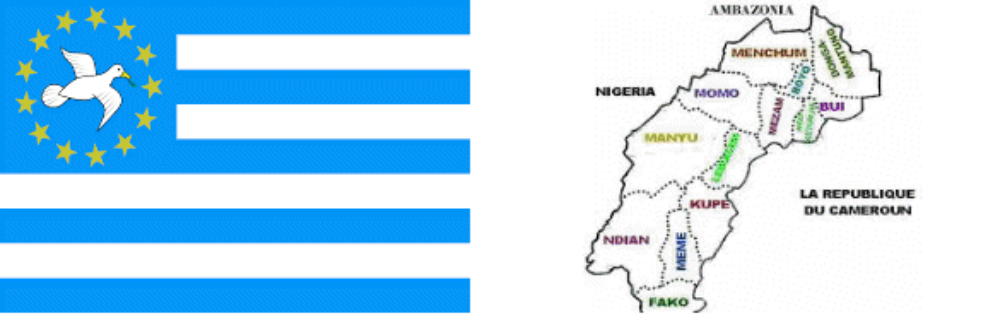Historical Review of the Republic of Ambazonia
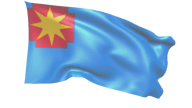
Historical Overview
- United Nations Trust Territory of Southern British Cameroons (1946–1961)
- League of Nations Mandated Territory Under United Kingdom Administration (1922–1945)
- British Captured Territory after the defeat of Germany in World War I; (1916–1922)
- Ambas Bay Colony 🗗 founded by English Baptist Missionary Society with capital at Victoria (1858 – 1887)
- First Westphalia state in the Gulf of Guinea
The Republic of Ambazonia is the former United Nations Trust Territory of Southern British Cameroons. It is located between Nigeria 🗗 to the west and north, and Cameroun to the east; it is wedged between West Africa 🗗 and the former French Equatorial Africa. If independent, Ambazonia would share maritime boundaries with Nigeria 🗗, the Republic of Cameroon and Equatorial Guinea 🗗.
Ambazonia has a land size of 43,000 square kilometers and a population of approximately 6 million people according to the Cameroon state census (the census has long been subject to political manipulation; the number is likely closer to 8 million). It is thus slightly larger than the Netherlands 🗗, ranked the 131st largest 🗗 country and has about as many inhabitants as Paraguay, the world’s 93rd largest country in terms of population. (In other terms, Ambazonia is more populous than at least 60 UN and 18 African Union (AU) Member States, and is larger in area than at least 30 UN and 12 AU Member States.)
Ambazonian History
In 1884 The Ambas Bay Colony with capital at Victoria was founded by Alfred Saker of English Baptist Missionary Society. The territory was ceded to Germany in 1887 after Germany had established the protectorate of Kamerun in July 1884. In November 1911, Kamerun was augmented by a cession of 270,00 sq. km of land from French Equatorial Africa (new region is named NeuKamerun-Ost & NeuKamerun-Süd).
In 1916 the Armies of France, Britain and Belgium jointly defeated Germany in the Kamerun and took over the territory, sharing it between France and Britain. The arrangement was made law by the Anglo-French Treaty of that same year and formalized in the Treaty of Versailles on 28 June 1919. France which occupied 80 percent of Kamerun immediately reunited the 270,000 sq. km. of land she had ceded to Germany in November 1911 back to French Equatorial Africa; while her remaining portion of Kamerun was christened French Cameroun. Britain on the other hand which contended itself with 20 percent of Kamerun named it British Cameroons.
Following the Treaty of Versailles, British Cameroons and French Cameroun became League of Nations Mandated territories in 1922, and then United Nations Trust Territories in 1946.
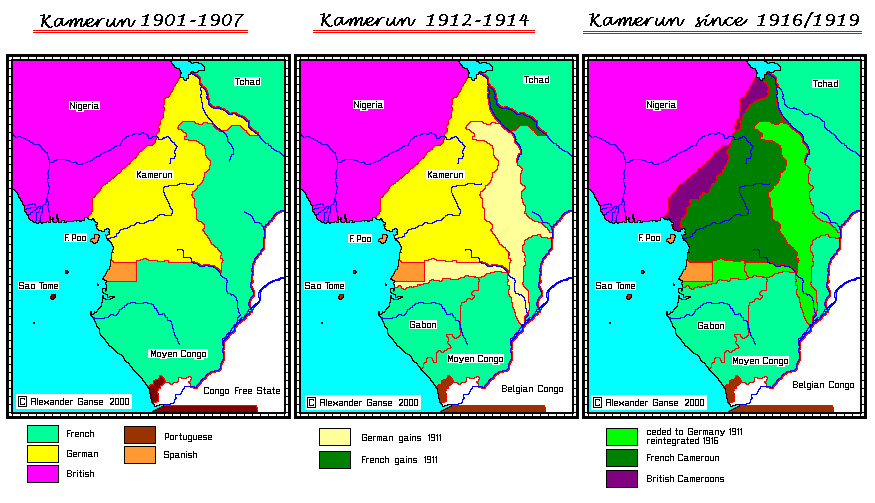
Britain, for administrative convenience, further divided British Cameroons into Northern British Cameroons & Southern British Cameroons. Northern British Cameroons was administered as part of Northern Nigeria while Southern British Cameroons was administered as part of Southern Nigeria. By the British Order in Council of 26 June 1923, Southern British Cameroons became a distinct territory from the Northern British Cameroons within the international trusteeship system, and a unit of self-determination. (See colonial Africa)
According to Article 76 (b) of The United Nations Charter, the basic objectives of the trusteeship system, was to promote the political, economic, social, and educational advancement of the inhabitants of the trust territories, and their progressive development towards self-government or independence………..
In 1954, Southern British Cameroons became a self-governing territory following her declaration of benevolent neutrality in the Nigerian Eastern House of Assembly. It had a legislature, Judiciary, House of Chiefs, and a prime minister (Dr. EML Endeley) who was also the Head of Government. In 1959, multiparty elections were held and the opposition candidate, Dr. John Ngu Foncha became the Prime Minister following a peaceful transfer of power, something that has not happened in French Cameroun and many other African Countries to this date.
When it came to decolonization, that is, granting self-government or independence to the Trust Territories, the United Nations made several blunders concerning British Cameroons. In the case of Southern British Cameroons, the United Kingdom carried out what analysts say is the most sophisticated slave trade deal under the cover United Nations, i.e., Southern British Cameroons was sold to France for a meager sum of 20,000,000 pounds which the British had invested in the Common wealth development corporation (CDC) according to British declassified documents.
Thus, while French Cameroun became independent as Republic of Cameroun on 1 January 1960, a plebiscite was forced on the people of British Cameroons in February 1961 to choose whether they wanted to achieve independence by joining the already independent Republic of Cameroon or joining the Federal Republic of Nigeria (Nigeria had independence on 1 October 1960). This was in violation of UN General Assembly Resolution 1514 of 14 December 1960 which affirmed that independence was the inherent and inalienable right of all colonies and trust territories as a guarantee for the enjoyment of their complete freedom. Since the plebiscite was conducted separately between the Northern & Southern British Cameroons, the people of Northern British Cameroons voted overwhelmingly to remain part of Nigeria while the majority of the people of Southern Cameroons voted to achieve independence by joining the Republic of Cameroun in a loose confederation. (See The Two Alternatives Part 2 -Republic of Cameroon and Southern Cameroons)
It should be noted that France and all independent French-speaking countries of West and Central Africa (including Republic of Cameroun itself) all voted against UN General Assembly resolution 1608(XV) on unification between Republic of Cameroun and Southern British Cameroons on April 21, 1961. In spite of this opposition from France and Republic of Cameroun itself, the resolution was adopted by the UN General Assembly.
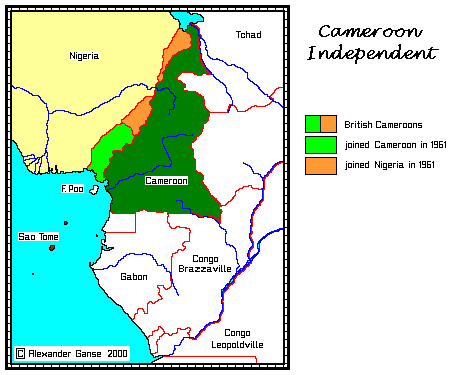 | 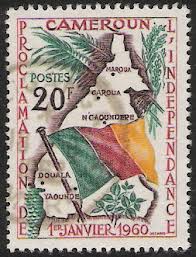 |
Since then, the fate of the Southern British Cameroons and the UN Resolution 1608(XV) of 21 April 1961 has been in violation by Republic of Cameroun, France, Britain and the United Nations itself now for forty years. (See Breach of International Obligations by Justice Muluh Mbuh) Paragraph 5 of UN Resolution 1608(XV) demanded that the contracting parties, that is Republic of Cameroun, Government of Southern British Cameroons, Britain and France should convene urgent discussions, which would be supervised by the United Nations Trusteeship Council, to ensure that an agreement of the Cameroon Federation was reached before the termination of the Trusteeship of the Southern British Cameroons.
The discussions which were held in Foumban (French Cameroun) from 17 – 21 July 1961 were to draw up a charter for the running of a two-State system within the federal political arrangement (See The Two Alternatives Part 2). These discussions were neither attended by UN Representatives nor by Britain leaving the Southern Cameroons at the mercy of crude French Cameroun politicians and French Technical Advisers; and France, eager to maintain treaties it had signed with French Cameroun at independence which rendered French Cameroun’s independent null and void (since France controlled Cameroun’s defense, economy, currency, imports and exports, etc.), co-opted the Southern Cameroons into the Republic of Cameroun. No union agreement was produced and consequently, no document was presented either to the National Assembly of Republic of Cameroun or to the Southern British Cameroons House of Assembly for ratification on the union between Republic of Cameroun and Southern British Cameroons. However, President Ahidjo unilaterally proclaimed into being the Federal Republic of Cameroon; Cameroon army marched into Southern British Cameroons on 30 September 1961 and the two states simply celebrated unification on 1st October 1961. Southern British Cameroons was henceforth called West Cameroon while Republic of Cameroun was called East Cameroon.
Article 102(1) of Charter of the United Nations states inter alia: “Every treaty and every international agreement entered into by any Member of the United Nations after the present Charter comes into force shall as soon as possible be registered with the Secretariat and published by it.” Therefore, the Federal republic of Cameroon was an illegal country because no treaty was ever signed between Ahidjo & Foncha uniting the two countries and no treaty of union between Southern British Cameroons and Republic of Cameroun has ever been deposited at the UN according to article 102(1) of Charter of the UN.
Even with this illegal arrangement, article 47(1) of the Constitution of the Federal Republic of Cameroon (a modified version of the Constitution of the Republic of Cameroun) stated inter alia, that: “No bill to amend the Constitution may be introduced if it tend to impair the unity and integrity of the Federation”. But Ahidjo, the President of the Federal Republic, moved to abolish the federation as early as 1966. Whereas John Ngu Foncha and Augustine Ngum Jua, leaning on article 47 of the Federal Constitution objected, Solomon Tandeng Muna took the opposite direction. And by a presidential decree of 1968, Ahidjo replaced Foncha & Jua with the colluding Muna; who now doubled as the Vice President of the Federation, and the Prime Minister of the Federated State of West Cameroon with residence in Buea. Four years later, on 20 May 1972, Ahidjo in violation of the said article 47 of the Federal constitution stage-managed a referendum which led to the complete dismantling of the federal structures in favor of a unitary state system; thereby transforming the ccountry into the United Republic of Cameroon. Southern British Cameroons which was already divided into six regions (Mamfe, Kumba, Victoria, Bamenda, Wum, Nkambe) was then made into South West & North West provinces of Cameroon; while East Cameroon was divided into Northern, Western, Littoral, Central South and Eastern provinces of Cameroon.
In 1984, by Law No 84/1 of 4 February 1984, Paul Biya committed high treason by seceding The Republic of Cameroun from the now illegal United Republic of Cameroon. By doing this, he revert the name of the country back to the Republic of Cameroun, the name by which French Cameroun gained independence on 1 January 1960. He went on to further divide East Cameroon (Republic of Cameroun) into Far North, North, Adamawa, West, Littoral, East, Centre, and South Provinces.
On 20 March 1985, Fon Fongum Gorji-Dinka, the first president of the Cameroon Bar Association and also a QC; CC; & ACP challenged Law 84/01 by publishing a pamphlet titled THE NEW SOCIAL ORDER. This pamphlet denounced what Fon Dinka saw as the gross mismanagement of Cameroon, dwelling particularly on the Southern Cameroons problem. In Dinka’s terms, Republic of Cameroun had annexed the Southern Cameroons; and he advocated for the creation of a Southern Cameroons state to be called Ambazonia. The name Ambazonia (the zone or hinterlands of Ambas Bay) was chosen so as not to confuse Sothern British Cameroons with South Province of Cameroun; or West Cameroon with the West province of Cameroun. The New Social Order, predictably, provoked the fury of the Biya regime, and Fon Dinka sought refuge at the British Embassy.
On 5 May 1985, Fon Dinka wrote An Open Letter to L’etat Major of Cameroun asking them to defuse the timed bomb. This led to his arrest on 31 May 1985, and he was taken from Bamenda (Ambazonia) to Yaoundé, where he was detained in a wet and dirty cell without a bed, table or any sanitary facilities. He fell ill and was hospitalized. After having received information on plans to transfer him to a mental hospital, he escaped to the residence of the British Ambassador, who rejected his asylum request and handed him over to the police. On 9 June 1985, the author was re-detained at the headquarters of the Brigade Mixte Mobile (BMM), a paramilitary police force, where he initially shared a cell with 20 murder convicts.
While in jail, one Prison Guard questioned Fon Dinka whether his crime was one by which he could not work out some compromise with the government, lamenting that it was terrible for a country to see its highest lawyer behind bars! It is not certain whether the officer was sent by government or whether it was his own private initiative. It quickly occurred to Fon Dinka that this was an opportunity to ask and utilize a typewriter and make clear his intensions of not willing to give up simply on some compromise without actually having the government fully understand the implications of their actions, while correcting them.
The Prison Guard returned to government officials that morning boasting that the Anglo leader in jail has just told him he was willing to confess his crime against government and that he has demanded a typewriter to type out his confession. The Fon was to wear a smile when he returned with a typewriter the following morning. After a few days, Fon Dinka issued what the Prison Guard took to the Cameroun government as a confession; which turned out to be another pamphlet called The Rebellion of Ambazonia issued on 11 July 1985.
As a result of the physical and mental torture he was subjected to during detention, Fon Dinka suffered a stroke which paralyzed his left side. This provoked the so-called “Dinka riots”, whereupon schools closed for several weeks. On 11 November 1985, Parliament adopted a resolution calling for a National Conference to address the Ambazonian question. In response, President Biya accused the President of Parliament of leading a “pro-Dinka” parliamentary revolt against him; he had the author charged with high treason before a Military Tribunal, allegedly asking for the death penalty. The prosecution’s case collapsed in the absence of any legal provision which would have criminalized the author’s call on President Biya to comply with the Restoration Law by withdrawing from Ambazonia. On 3 February 1986, the author was acquitted of all charges and released from detention.
President Biya’s intention to appeal the judgment, after having ordered Fon Dinka to be rearrested, was frustrated because the law establishing the Military Tribunal did not provide for the possibility of appeal in cases involving high treason. Paul Biya then became furious and put Fon Dinka under house arrest between 7 February 1986 and 28 March 1988.
On 28 March 1988, Fon Dinka escaped to Nigeria and in 1995, he went to Great Britain, where he was recognized as a refugee and became a barrister.
On 10 October 1990, The Ambazonian Restoration Council made a Proclamation formalizing the independence of Ambazonia. It designated the spearhead of the liberation struggle HRH Fon Gorji-Dinka the Head of State of the Republic of Ambazonia. The proclamation with a case titled AMBAZONIA vs LA REPUPLIQUE DU CAMEROUN was filed at the United Nations with a charge that La Republique du Cameroun (Republic of Cameroun) is illegally occupying Ambazonia, and demanded UN action to terminate this illegal occupation of Ambazonia by Cameroun.
On the 5th of October 2023 Dr Florentin Fonche became the President of the Republic of Ambazonia after wining through elections. As part of the Special Rescue Mission (SRM) he declared his Government on the 7th of October 2023. He promised contnue with the Special Rescue Mission (SRM). It is important to note that the elections organised and mornitored by the Tripartite Alliance (Indigenous People of Ambazonia (IPOA) – Ambazonians who Aspire to Secure and Protect the Integrity of the Revolution (ASPIRE) – African Freedom Advocacy (AFA)). On the 9th of October 2023, President Dr Florentin Fonche appointed His Eminence Archbishop Michael Nchang Abongwa as PRIME MINISTER OF THE REPUBLIC OF AMBAZONIA (RoA).
The Struggle to Terminate Cameroun’s Occupation of Ambazonia
In 1991, The U.S-Ambazonian dialogue held its first meeting under the Chairmanship of the African Affairs Assistant under Secretary Irving Hicks. U.S agrees that Cameroun indeed is illegally occupying Ambazonia and after reviewing the options concluded that only a unilateral U.S action could get Biya out of Ambazonia. U.S then required from Ambazonia a declaration by a national or international tribunal on the matter.
In 1992, Fon Gorji-Dinka, on behalf of the state of Republic of Ambazonia filed suit against the Republic of Cameroon and President Paul Biya on the main charge of Cameroon’s illegal and forcible occupation of Ambazonia since the 1984 dissolution of the United Republic of Cameroon and the declaration of the Republic of Ambazonia. This suit was registered with the Bamenda High Court in the North West region of Cameroon as case number HCB/28/92 in which the Bamenda High Court reached a decision according to which the court among other things held:
That President Ahidjo is guilty of treason for staging the coup d’etat of 2/6/72 which dissolved the union between the first defendant and the first plaintiff styled The Federal Republic of East and West Cameroon.
That President Biya is [also] guilty of treason for furthering and completing the treason of Ahidjo by bringing about the secession of the first defendant (East Cameroon) from the United Republic of Cameroon on February 4, 1984, restituting its name “The Republic of Cameroon” which had been extinct since October 1, 1961.
That the break-away Republic of Cameroon continues to ILLEGALLY AND FORCIBLY OCCUPY the territory of the first plaintiff, which means the first defendant, is guilty of an international offence of Aggression & Annexation.
That the report made the Restoration of the Statehood of the first plaintiff the starting point of restoration of legality.
In 1993 Ambazonia began active correspondence with foreign governments; and in January of the same year, Fon Dinka on behalf of the 5.5 million people of Ambazonia wrote a letter to the Fourth Committee of the UN General Assembly asking the secretariat of the Fourth Committee to take appropriate action to restitute the peoples’ right to self-determination for which purpose the concept of International Trusteeship Administration was designed.
In May 1994 Ambazonia intervenes in the Bakassi proceedings: The Ambazonian inter-pleader summons deposited in the United Nations by special courier, and in the International Court of Justice (ICJ) by registered US mail. Fon Fongum Gorji-Dinka in his capacity as the Head of State of Ambazonia declared Ambazonia’s acceptance of the Jurisdiction of the ICJ in all disputes; and that this declaration shall remain in force ad infinitum but subject to review by Ambazonia Government. On the instructions of the French/Algerian President of the Court, the registrar rejected it. Consistent with the rules of ICJ, Ambazonia appealed against the President’s decision but the President blocked his faulty decision from being submitted to the whole Court. In total frustration Fon Dinka got Ambazonia’s Delegates in North America to try reviving the US-Ambazonia dialogue. Congressman Tim Penny got involved and drew the attention of Secretary of State Madeline Albright who wrote the ICJ but got no more than the calendar of fixtures for the case.
In 1997, Fon Dinka got the High Court of London to compel the British government to accept the transfer of the Fon’s asylum from Nigeria to Britain. He took the advantage to assert the fact that the ethnic people of Ambazonia retain British citizenship till Ambazonia became free from Cameroon under which Britain illegally subjugated them. The British Government conceded:
That Cameroon’s occupation of Ambazonia is illegal and forcible, and
That British citizenship vested in ethnic Ambazonians (6.4 million) would only lapse when the country becomes free from Cameroon which is in fact a surrogate ruling Ambazonia for and on behalf of Britain.
On 31 January 2005, then UN secretary General, Kofi Annan flew to Yaounde, Cameroon and obtained a commitment [Annan Bakassi Peace Accord] from Paul Biya which states: “I president Biya of the Republic of Cameroon, in a bid to provide lasting peace to the Bakassi conflict hereby commit myself and government to respect the territorial boundaries of my country as obtained at independence”. This is a self incriminating statement because the boundaries of Cameroon (French Cameroun) at independence do not include Ambazonia where Bakassi rightfully belongs. The accord has not been made public by the UN but news about it is contained in Press Release SG/T/2434 of 01/02/2005.
In March 2005, the United Nations Human Rights Committee (International Covenant on Civil and political Rights) CCPR/C/83/D/1134/2002 ruled that Fon Dinka is entitled to an effective remedy, including compensation and assurance of the enjoyment of his civil and political rights. And that Cameroon is also under an obligation to take measures to prevent similar violations in the future. Paragraph 2.5 states: As a result of the “subjugation” of Ambazonians, whose human rights were allegedly severely violated by members of the Franco-Cameroonian armed forces as well as militia groups, riots broke out in 1983, prompting Parliament to enact Restoration Law 84/01, which dissolved the union of the two countries. The author then became head of the “Ambazonian Restoration Council” and published several articles, which called on President Paul Biya of the Republic of Cameroon to comply with the Restoration Law and to withdraw from Ambazonia.
In November 2005, Fon Dinka sent a Courier to Paul Biya (through Ephraim Inoni, the Prime Minister at that time) asking Paul Biya “to put an end to the subjugation of Ambazonia under la Republique du Cameroun”. The courier which was sent via DHL was received on 7 November 2005 and in it Fon Dinka stated that Paul Biya’s peaceful withdrawal from Ambazonia would lead to the creation of a Confederacy of Ambazonia and Cameroon Independent Nations (CACIN) in accordance with the terms and procedure set out in the United Nations plebiscite manifesto THE TWO ALTERNATIVES published in the Southern Cameroons gazette of 27th January 1961.
In April & May 2009, UN surveyors planted boundary pillars separating Cameroon from Ambazonia. In December of the same year (2009), Fon Dinka wrote a letter titled “Bakassi deal invalid” to world court pointing out that the fact Paul Biya signed the Annan Bakassi Peace Accord to withdraw to his country’s boundaries as obtained at independence is a self-incriminating admission that Cameroon occupation of Ambazonia is the source of the Bakassi conflict.
On 20 May 2010 (Cameroun national day), the president of the UN General Assembly, Dr. Ali Abdussalam Treki presented a gift of two giant framed maps to Paul Biya. One of the maps is clearly that of Republic of Cameroun (French Cameroun) as of 1 January 1960 and British Cameroons, while the second map is that of British Cameroons clearly demarcating Southern & Northern British Cameroons.
In October 2011, The Ambazonian Head of State wrote an open letter to Paul Biya titled We Must Prevent A Blood Bath. This was reminder to the Courier sent to Paul Biya in November 2005 asking him “to put an end to the subjugation of Ambazonia by La Republique du Cameroun”. The Ambazonia Head of State wrote this open letter because he wanted it to be on public records and also because the courier he sent to Paul Biya through PM Ephraim Inoni was not honoured with even an acknowledgement of receipt. This letter was published by The Post Newspaper on Thursday October 24, 2011.
It should be noted that the legalistic approach which Ambazonia adopted has saved her people 30 years of guerrilla warfare. It took Eritrea decades of blood bath to force Ethiopia to recognize the sovereignty of Eritrea. Western Sahara has been in the struggle for decades to get independence from Morocco all in vain even though some countries have accorded diplomatic recognition to Western Sahara. Each has the same type of case as ours; i.e., internationally recognized boundaries separating each of them from the occupying aggressor country.
Under article 51 of the UN Charter the victim of aggression is entitled to use force to terminate the aggressions.
Article 4(b) of the African Union constitutive act stipulates that member states should respect borders existing on achievement of independence. We all know that Republic of Cameroon and Ambazonia have internationally recognized boundaries; hence independence for Ambazonia would be won sooner rather than later with or without the use of force.
A Luta Continua! (The Struggle Continues!)
The National Anthem
Hail Ambazonia, Land of Glory
HAIL HAIL HAIL THIS Land of Glory
We the Ambazonians pledge your loyalty
Praise the Son our Saviour who granted us the freedom,
Allegiance to the heroes who bore the land with their blood,
Glory to glory we rise and never to fall,
Here in our nation flowing with milk and honey,
Glory, glory, glory to the father,
For making you a nation a joy forevermore.
Ambazonia, land of freedom you shall live in plenty meeting our needs,
And your children shall be like the stars above,
The Most High God be the Watchman of this Nation.
Ambazonia, land of freedom you shall live in plenty meeting our needs,
And your children shall be like the stars above,
The Most High God be the Watchman of this Nation.
The National Emblem
Pax Dei
The Reign of God the Omnipotent, Omnipresent, and Omniscient on earth.
The Ambazonian Emblem
Official Emblem of the Information Bureau
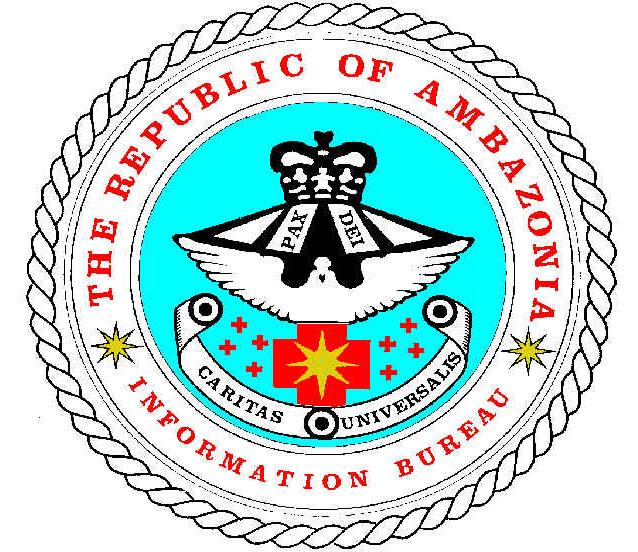
The Ambazonian Emblem
Official Emblem of the Information Bureau
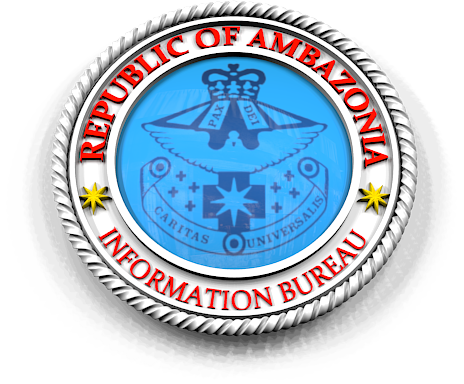
The National Pledge
The Flags of Ambazonia
There are two flags of the Republic of Ambazonia. There is the modern and popular one and there is an old traditional flag.
Today’s Flag of Ambazonia
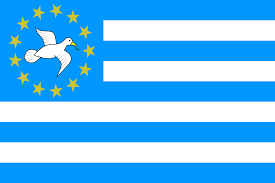
Description of today’s modern and popular Flag of Ambazonia (1999, 2017)
It has Nine horizontal stripes, in turn blue and white; a dove surrounded by 13 stars on a blue square field in canton. Depending on whom you speak to the symbolisms of the Flag varies.
- Blue: Democracy, the plurality of the people and the rule of law, potential for growth and development, and for faith in God.
- White: Purity, transparency, accountability in life and governance, and intolerance of mediocrities and corruption.
- Dove: Principles of God, peace and tranquility.
- Green leaves carried by the dove: Assurance of good news even in stormy circumstances, truth and justice, a promise of peace, prosperity, productivity and success.
- 13 stars: The 13 regions (counties) of Ambazonia.
- Golden color: Priceless value of all regions (counties), balanced development, and equity and equality among the counties.
- The dove’s flight: Visionary focus, hard work, liberty and freedom.
The old (First / Traditional) Flag in The Map
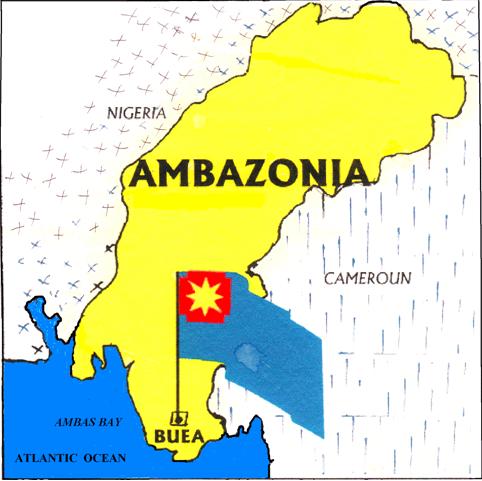
The old (First / Traditional) Flag
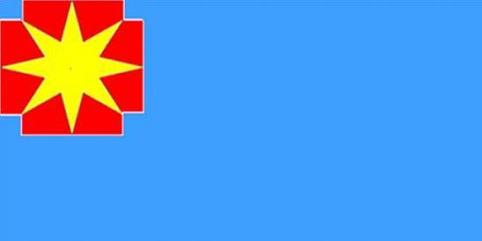
Description of the old (First / Traditional) Flag of Ambazonia
Sky Blue signifies universal love; The Red Cross is our obligation to bear each other’s burden; The 8 points star is the victory from all corners of the world which comes when we show love even to our most implacable enemies.
Regions (Counties)
Map of Ambazonia showing 13 Regions (Counties)
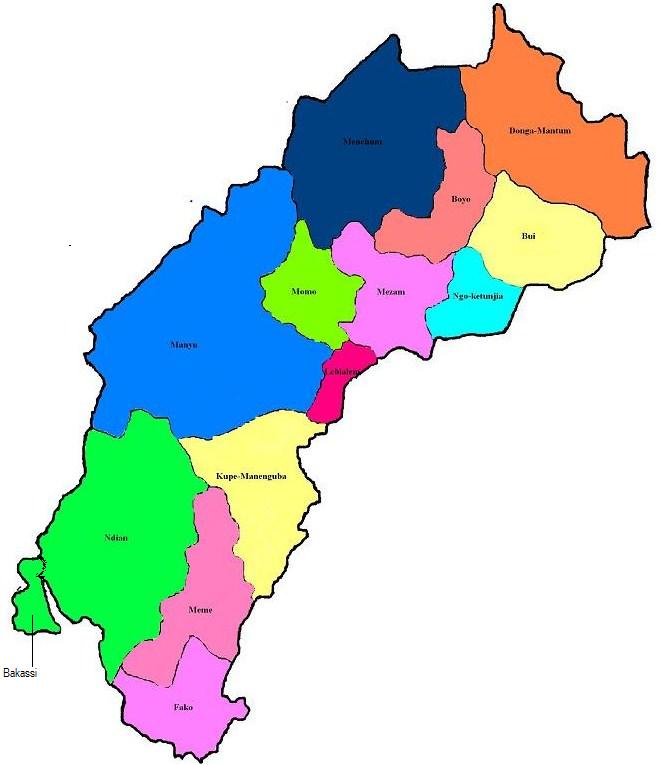
Regions (Counties) and Local Government Areas of Ambazonia
| Region (County) | Capital City | LGA | Chief Town |
|---|---|---|---|
| Boyo | Fundong | Muwom | Belo |
| Yang | Njinikom | ||
| Juaffef | Fundong | ||
| Kimbi | Fonfuka | ||
| Bui | Kumbo | Jakiri | Jakiri |
| Oku | Elak | ||
| Noni | Nkor | ||
| Nkum | Tatum | ||
| Kumbo | Kumbo | ||
| Mbveng | Mbiame | ||
| Donga Mantung | Nkambe | Ako | Ako |
| Misaje | Misaje | ||
| Ndu | Ndu | ||
| Nkambe | Nkambe | ||
| Nwa | Nwa | ||
| Fako | Victoria | Victoria | Victoria |
| Buea | Buea | ||
| Tiko | Tiko | ||
| Muyuka | Muyuka | ||
| Kupe- Muaneguba | Bangem | Bangem | Bangem |
| Tombel | Tombel | ||
| Nguti | Nguti | ||
| Lebialem | Menji | Alou (Clouds) | Alou |
| Menji | Menji | ||
| Wabane | Wabane | ||
| Manyu | Mamfe | Mamfe | Mamfe |
| Akwaya | Akwaya | ||
| Ngunaya | Kembong | ||
| Njemaya | Eyumojock | ||
| Tinto | Tinto | ||
| Meme | Kumba | Kumba | Kumba |
| Konye | Konye | ||
| Mbonge | Mbonge | ||
| Menchum | Wum | Wum | Wum |
| Fungom | Zhoa | ||
| Menchum Valley | Benakuma | ||
| Furu Awa | Furu Awa | ||
| Mezam | Bamenda | Bamenda | Bamenda |
| Tubah | Bambui | ||
| Bafut | Bafut | ||
| Bali | Bali | ||
| Santa | Santa | ||
| Momo | Mbengwi | Mbengwi | Mbengwi |
| Batibo | Batibo | ||
| Ngie | Andek | ||
| Njikwa | Njikwa | ||
| Widikum-Menka | Widikum | ||
| Ndian | Mundemba | Mundemba | Mundemba |
| Ekondo Titi | Ekondo Titi | ||
| Bamusso | Bamusso | ||
| Kombo Abedimo | Kombo Abedimo | ||
| Issangele | Issangele | ||
| Idabato | Idabato | ||
| Kombo Etindi | Kombo Etindi | ||
| Ngoketunjia | Ndop | Ndop | Ndop |
| Balikumbat | Balikumbat | ||
| Babessi | Babessi |
Linguistic Map
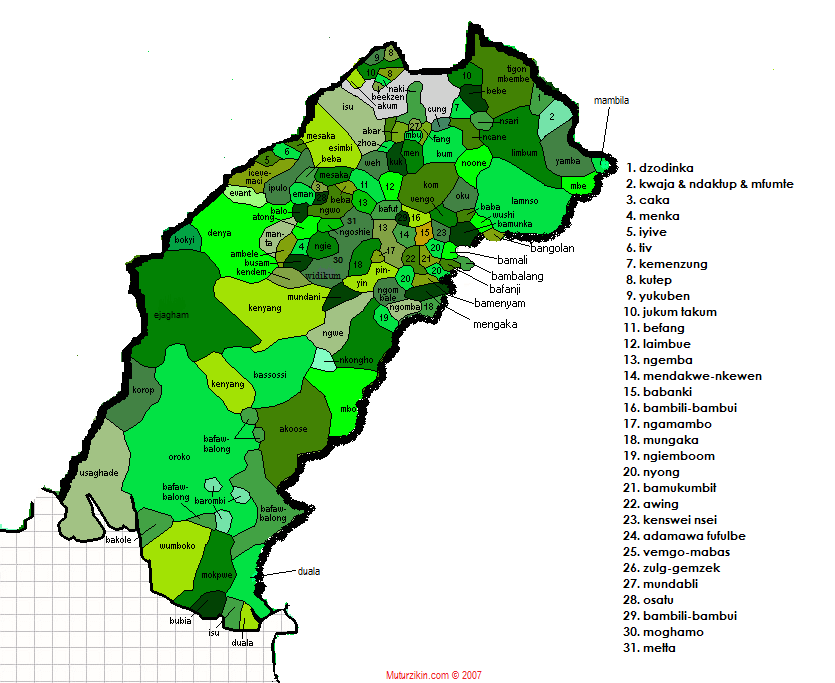
Relief and Vegetation
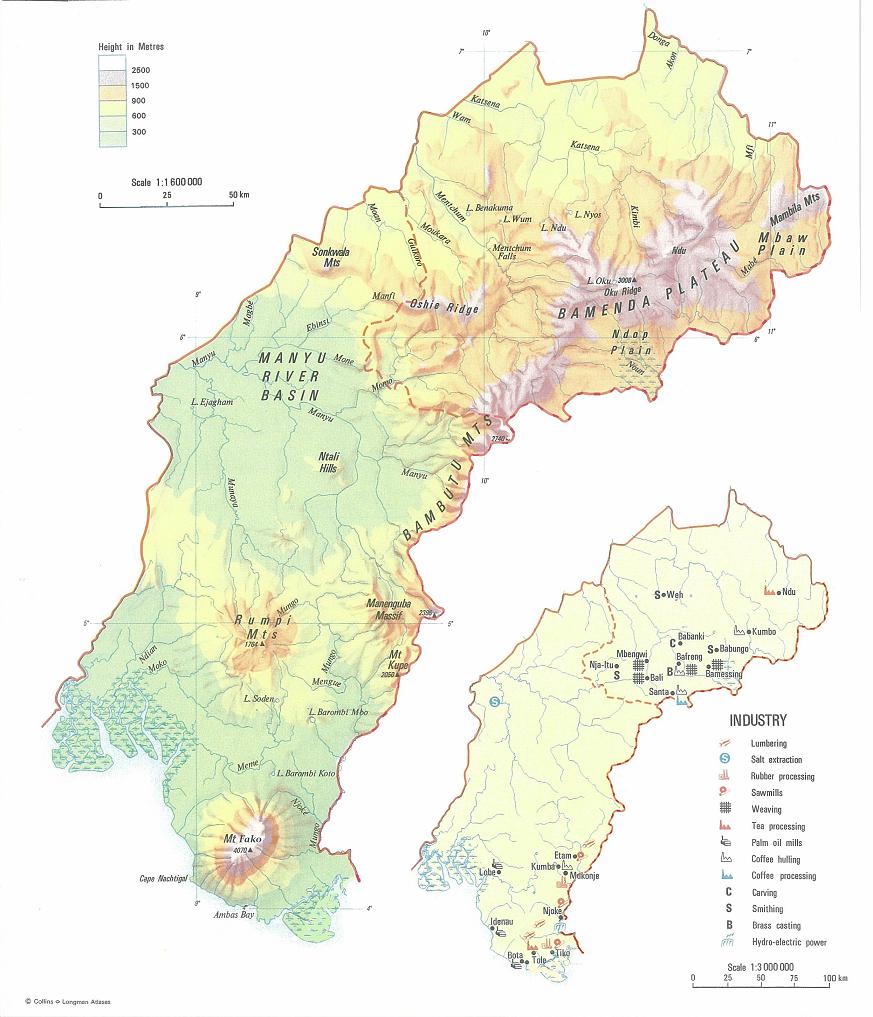
Cities, Towns and Villages
Northern Region
Abafu; Abafum; Abahun; Abebong; Abedug; Abegum; Abonkwa; Abonshe; Abu; Abunkpa; Abunshie; Acha-Tugi; Ader; Adere; Afon Baba; Ajung; Ake; Ako; Akoja; Akonko; Akum; Akuwu; Akwaja; Akwato; Akwetto; Akwonse; Alabukang; Ama; Amalive; Amanavil; Amba; Ambo; Ame; Andek; Andi; Andu-Bombo; Angie; Angwi; Anong; Ashong; Assa; Azem;
Baba; Baba I; Babanki; Babanki-Tungo; Babessi; Babosa; Babossa; Babungo; Badji; Badzumbo; Bafani; Bafreng; Bafut; Baicham; Baka; Bakanki; Bakanki-Tungo; Bako; Bakwe; Bali; Baliben; Balikumbat; Balso; Bamale; Bamali; Bambalang; Bamben; Bambili; Bambui; Bambuluwe; Bamenda; Bamessi; Bamessing; Baminje; Bamumkumbit; Bamundum; Bamunka; Banbungo; Bancoupen; Bande; Bandeng; Bangola; Bangouren; Bania; Banja; Bantakpa; Bassa; Bat; Batabi; Batamo; Batari; Batebi; Batibo; Batomo; Bebe Ketti; Bebe-Keti; Befang; Bello; Benakoma; Benakuma; Benakumo; Benchansi; Berabi; Bessi; Bessom; Bifang; Big Babanki; Bindi; Binka; Binshua; Bissa; Boffee; Bogu; Boku; Bossa; Bu; Bum; Bwabwa
Cha;
Diche; Dil-Bafum; Djingbe;
Efah; Eka; Elom; Enwen; Enyoh; Essu; Etinachong; Ewai;
Fang; Fofuka; Fonfukka; Fugua; Fujua; Fulani; Funam; Fundong; Fungom; Furu-Awah;
Gajama; Gayama; Guneku; Guzang
Isu; Itchimo; Iwo;
Jakiri
Kam; Kamine; Kaw; Kijom-Keku; Kishong; Kishung; Ko; Koaw; Komine; Konene; Kong; Koskin; Koubokam; Kubokam; Kugwe; Kuk; Kumbo; Kumfutu; Kunjang; Kurabei; Kuruku; Kwana; Kwe;
Laa-Bum; Laakom; Laikom; Lain; Lasin; Lassin; Lau; Lue; Lus; Lwo;
M’bwal; Maisaji; Mankon; Manta; Mashi; Matazu; Mba; Mbakong; Mbande; Mbandi; Mbengo; Mbengok; Mbengwi; Mbguri; Mbiam; Mbiame; Mbinkas; Mbiribua; Mbot; Mbriwa; Mbriwe; Mbu; Mbuk; Mbulom; Mbunjei; Mbwat; Me; Mejang; Mejung; Meli; Melim; Melong; Mengen-Mbo; Menka; Mezang; Missaje; Missong; Mme; Mme-Bafumen; Modele; Modelle; Mubadji; Mubaji; Mufo; Mukuru; Mundabi; Mungong; Munji; Munka; Munken; Munkep; Mutaso; Mven;
Nanso; Nchain; Nchang; Ndaka; Ndek; Ndop; Ndu; Ndun; Ngeu’s; Ngong; Ngonu; Ngotin; Ngunu; Ngwenjin; Ngyen-Muwa; Njimingie; Njinikom; Njintom; Njotin; Nkambe; Nkang; Nkannye; Nser; Nsop; Nsungli; Ntenkissu; Ntumbaw; Numben; Numben; Nyajua; Nyenjei; Nyos; Nyos-Acha
Ober-Furu; Okorobi; Oku; Olullu; Oshie; Oshum; Ossato; Ramunka; Rom
Sa; Sabga; Santa; Sawe; Sowe; Su; Subum
Tabessob; Tala; Tedji; Teze; Tiben; Tiben; Tikom; To; Tsoka; Tudji; Tugi; Tumbu; Tuml; Tungie
Ve
We; Widikum; Wum;
Zhoaw; Zoa; Zumpere
Southern Region
Abakpa; Abat; Abonando; Afap; Aiyumojok; Aiyundep; Ajaman; Ambas Bay; Ambas Island; Ambesu; Araru; Ashum; Asung; Ataremboh; Atop; Awa; Ayukaba;
Baba; Bachuo Akagbe; Bachuo Ntai; Badje; Badje Ndop; Badjoki; Baduma; Bafaka; Bafia; Bai Bikom; Bai Estate; Bai Foe; Bai Grass; Bai Kuke; Bai Longe; Bai Manya; Bai Panya; Bai Sombe; Bajo; Bakebe; Bakingili; Bakogo; Bakole; Bakossi; Bakumba; Bakundu Foe; Balungu; Bambele; Bambuko; Bamumbu; Banga Bekele; Bangale; Bangang; Bangem; Bangone; Banti; Barambi Mbo; Barombi Kang; Barombi Koto; Barombi Mokoko; Baru; Basseng; Batoke; Bavenga; Beach; Bechati; Bekatako; Bekili; Bekoli; Bekondo; Bekura; Bera; Besali; Besongabang; Bokwango; Bolifamba-Mile 16; Bonakanda; Bova; Buea (Gbea)
Djopongo; Dora; Dubange
Ebam; Ebiagwa; Ebie; Ebinsi; Ebobe; Eboko-Bajok; Ebonji; Ebota; Ebubu; Ebul; Edib; Edibinjok; Ediki; Ediki-Mbonge; Efolofo; Egumbuh; Ehom; Ekeb; Ekogati; Ekok; Ekombe-Balue; Ekombe-Bonji; Ekon; Ekona-Lelu; Ekona-Mbenge; Ekondo-Titi; Ekonema; Ekonjo; Ekumbe Liongo; Ekumbe Mofako; Ekume Ekundunene; Ekwe; Eshobi; Essossong; Essuke; Esuetan; Etam; Etemetek; Etoko-Mile 18; Etumba; Ewangabi; Ewele; Ewonda; Eyanchang; Eyang; Eyumojock
Faintschang; Feitok; Folepi
Great Soppo
Idenau; Ikange; Ikata; Ikenge; Iloani; Inokun; Isongo; Iteri; Itu
Ka; Kajifa; Kak; Kake; Kandonge; Kembong; Keme; Kendem; Kesham; Kita; Klein Mbobu; Kombone; Kombone Mission; Kongwe; Kosse; Koto; Koto I; Kotto ii; Kpokore; Kukaka; Kuke Bova; Kumba; Kumbe Balondo; Kumbe Balue; Kumin; Kumukumu; Kupe; Kurume
Lake Barombi-Koto; Lake Barombi-Mbo; Lake Mbwandong; Leme; Likoko; Likoko Membia; Likomba; Likombe; Likpki; Lilale; Lipenja; Lipenja Mukete; Lipenja Village; Lissoka (Lysoka); Lissombe; Liwenyi; Lobe; Lobe Village; Lokando
Mabela Creek; Mabeta; Mabonji; Mahole; Makobe; Makumane; Makunge; Malende; Mambanda; Mambanda Camp; Mamfe; Mamu; Mandese; Manga; Mange Samba; Mangundu; Manta; Manyemen; Mapanja; Marumba I; Marumba ii; Massaka I; Masuma; Matango; Matondo I; Matondo II; Mator Butu; Matumal Creek; Matute; Mbabe; Mbakang; Mbakem; Mbalangi; Mbange; Mbatop; Mbenge; Mbinda; Mbinjong; Mbogmut; Mbong; Mbonge; Mbonge-Meteke I; Mbonge-Meteke II; Mbule; Meveo (Tole); Mfuni; Mkpot; Mofako; Mussaka; Mutengene; Muyuka
Nake Bongwana; Narendi; Nchang; Ndissi; Ndoi Bakundu; Ndondono; Ndongo; Ndum; Nduma; Nekwai; New Bonako; New Butu; Nfaitock; Ngab; Nganjo; Nganjo Bolende; Ngeme; Ngenye; Ngolo Metoko; Ngombombeng; Ngongo; Ngussi; Nguti; Ngwenge; Njeke; Nkawkaw; Nkong; Nsanakang; Nsuke; Ntenako; Nyale; Nyang; Nyange; Nyassosso
Ogomoko; Oka; Ombe; Ombe Rein; Onge River; Ossele; Ossing; Owe
Palabongo; Peng; Pesikombe; Pete; Pundu; Pungo
River Uve
Sahbeeze; Sasse; Saxenhof; Small Ekombe; Small Massaka; Small Moundu; Small Ngwandi; Small Soppo; Sokulang; Sone;
Takwa; Tali; Tamben; Tawi; Tawo; Tiko; Tinto; Tombel; Tuge;
Victoria
Weme; Wututu;
Yoke; Yue; Yundi
